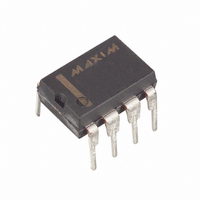DS1678+ Maxim Integrated Products, DS1678+ Datasheet - Page 21

DS1678+
Manufacturer Part Number
DS1678+
Description
IC REAL TIME EVENT REC 8-DIP
Manufacturer
Maxim Integrated Products
Type
Time Event Recorderr
Datasheet
1.DS1678STR.pdf
(25 pages)
Specifications of DS1678+
Memory Size
32B
Time Format
HH:MM:SS (12/24 hr)
Date Format
YY-MM-DD-dd
Interface
I²C, 2-Wire Serial
Voltage - Supply
4.5 V ~ 5.5 V
Operating Temperature
-40°C ~ 85°C
Mounting Type
Through Hole
Package / Case
8-DIP (0.300", 7.62mm)
Lead Free Status / RoHS Status
Lead free / RoHS Compliant
EVENT COUNTER REGISTER (3Ah–3Ch)
This three-byte register set provides the number of events that have been logged during the current data-
logging operation (also known as a “mission”). The contents of this register can be used by software to
point to the most recent data sample in the event-log memory. The data in these registers are cleared
when the event-log memory is cleared. The event counter is not incremented when the ETC reaches
FFFFh and rolls over to the next 16 bits of memory.
ADDRESS POINTER REGISTER (3Fh–40h)
The address pointer register always contains the address that the next data LSB is written to in the event-
log memory. The address pointer registers are located in the main memory map at LSB (3Fh) and MSB
(40h). These are helpful in recovering all the data if a rollover occurs. The address pointer points to the
oldest event in the memory after a rollover. This is the memory location that would be overwritten by the
next event. Read the data from this point to the end of the memory and the start time stamp, including the
two-byte ETC from the last event to recover all the data in the correct order.
GLITCH-CONTROL CIRCUIT
The DS1678 has a built-in glitch-control circuit to filter noise on INT from triggering false events. A
minimum of one internal clock cycle (0.122ms) up to a maximum of two internal clock cycles (0.245ms)
are required to recognize a transition on the input as an event. An event then requires an additional six to
eight internal clock cycles (0.752ms to 0.977ms) to be processed and recorded into memory. This means
that the minimum event occurrence that can be recognized by the DS1678 requires seven to 10 internal
clock cycles (0.854ms to 1.22ms). Failure to ensure this timing causes the event to be ignored. Thus, it is
recommended that you design with the maximum timing specs. See Figure 5.
INT has a weak internal pulldown resistor to prevent the pin from floating if the signal connected to the
pin is tri-stated. Without the resistor, the input would float and potentially log phantom events. With the
pulldown resistor, the pin can be transitioned to a low state, causing an event to be recorded if INT is held
high by an outside signal that becomes tri-stated.
Figure 5. Event Recognition Timing
GOOD EVENTS
BAD EVENT 1
BAD EVENT 2
INT
INT
INT
t
t
GLITCH
GLITCH
EVENT ON RISING EDGE
EVENT 1
EVENT 1
IS MISSED
EVENT 2
EVENT 2
t
EVENT
t
EVENT
TRANSITION
POINT
TRANSITION
POINT
TRANSITION
POINT
21 of 25
GOOD EVENTS
BAD EVENT 1
BAD EVENT 2
INT
INT
INT
t
t
GLITCH
GLITCH
EVENT ON BOTH EDGES
EVENT 1
EVENT 1 EVENT 2
IS MISSED
EVENT 2
t
t
EVENT
EVENT
TRANSITION
POINT
TRANSITION
POINT
TRANSITION
POINT






